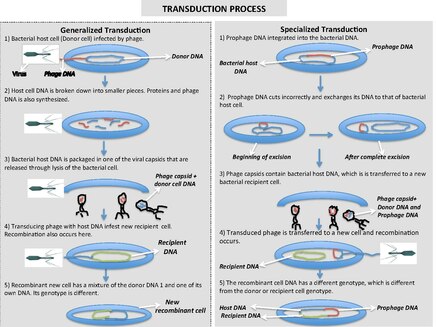
Back تنبيغ (علم الوراثة) Arabic Трансдукцыя (генетыка) Byelorussian ট্রান্সডাকশন Bengali/Bangla Transdukcija (genetika) BS Transducció Catalan Transdukce (genetika) Czech Transduktion (Genetik) German Transducción (genética) Spanish Transduktsioon Estonian Transdukzio Basque


Transduction is the process by which foreign DNA is introduced into a cell by a virus or viral vector.[1] An example is the viral transfer of DNA from one bacterium to another and hence an example of horizontal gene transfer.[2] Transduction does not require physical contact between the cell donating the DNA and the cell receiving the DNA (which occurs in conjugation), and it is DNase resistant (transformation is susceptible to DNase). Transduction is a common tool used by molecular biologists to stably introduce a foreign gene into a host cell's genome (both bacterial and mammalian cells).
- ^ Transduction, Genetic at the U.S. National Library of Medicine Medical Subject Headings (MeSH)
- ^ Jones E, Hartl DL (1998). Genetics: principles and analysis. Boston: Jones and Bartlett Publishers. ISBN 978-0-7637-0489-6.
© MMXXIII Rich X Search. We shall prevail. All rights reserved. Rich X Search